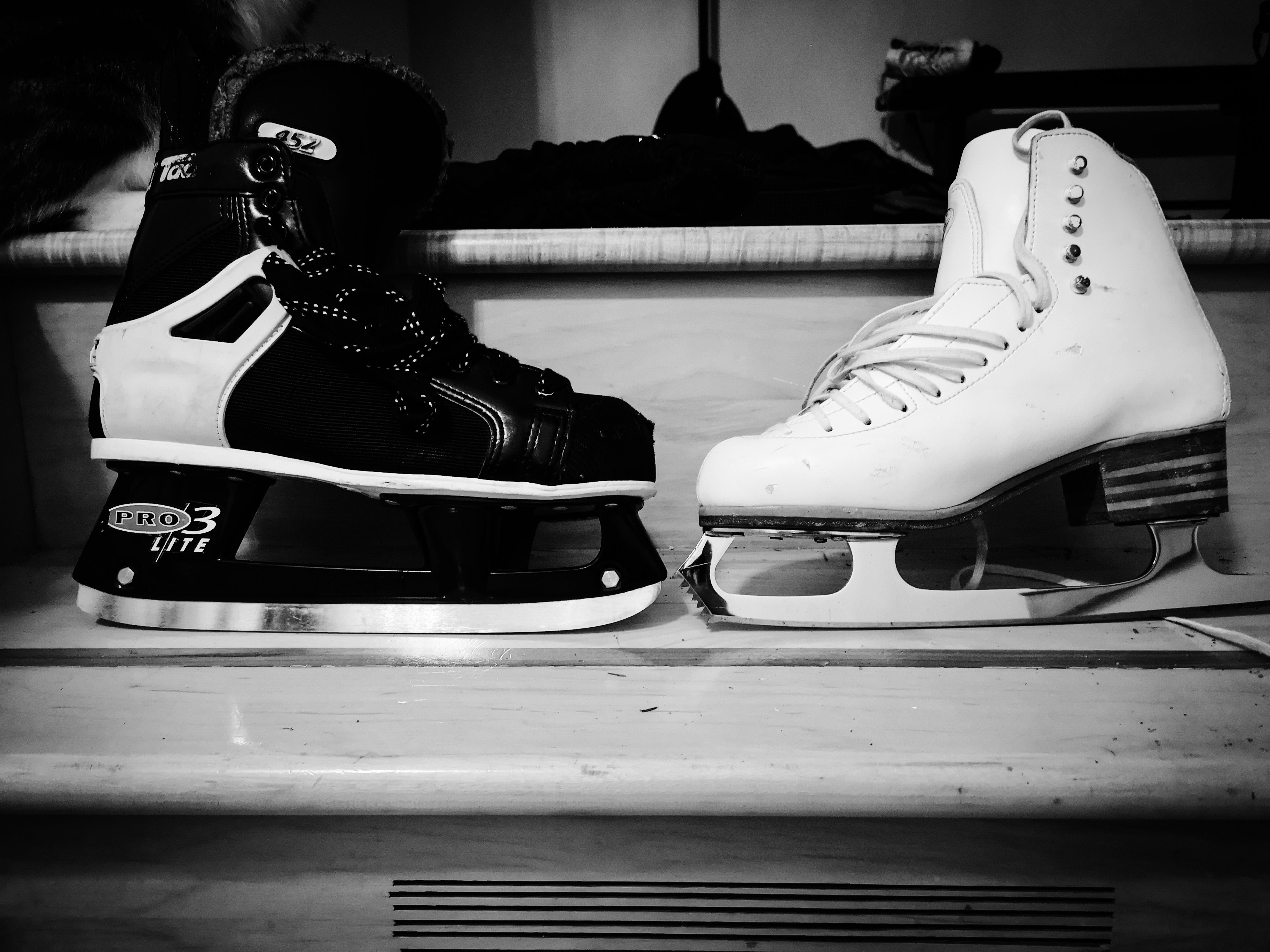Figure skates and hockey skates are designed for specific uses. Both offer unique advantages depending on the sport you play.
Understanding the differences between figure skates and hockey skates is crucial for athletes. Whether you are gliding gracefully on ice or speeding down the rink, the right skates make a big difference. Figure skates feature a toe pick and are more suited for jumps and spins.
Hockey skates offer agility and speed, perfect for fast-paced games. Knowing how each type serves its purpose can help you choose wisely, enhancing your performance on ice. Let’s explore the features and benefits of each, helping you find the ideal skates for your needs.
Design Differences
Choosing between figure skates and hockey skates can be challenging, especially if you’re new to ice sports. One of the key differences lies in their design. Understanding the design differences will help you make an informed decision that best suits your needs and goals on the ice.
Blade Shape
Figure skates and hockey skates have distinct blade shapes that cater to different activities.
Figure skates feature longer blades with a slight curve. The toe pick, a serrated edge at the front, allows for intricate moves and jumps. This design makes them ideal for performing spins and other technical maneuvers.
Hockey skates, on the other hand, have shorter, more curved blades. This design prioritizes agility and speed. The absence of a toe pick reduces the risk of tripping, which is crucial during fast-paced hockey games.
Boot Construction
The construction of the boots also varies significantly between figure skates and hockey skates.
Figure skate boots are typically made from layers of leather and are designed to provide more ankle support. They are often stiffer to help maintain stability during jumps and spins.
In contrast, hockey skate boots are usually made from synthetic materials. They offer a snug fit and are built to withstand the physical demands of the sport. The design focuses on protecting the feet from pucks and sticks, while also allowing for quick, agile movements.
Have you ever tried both types of skates? How did the different designs impact your performance and comfort on the ice?
Choosing the right skate depends on your specific needs and the activities you’ll be doing. Whether you’re aiming for graceful figure skating routines or intense hockey matches, understanding these design differences will help you pick the perfect pair.

Credit: www.youtube.com
Performance On Ice
Performance on ice varies greatly between figure skates and hockey skates. Each type of skate offers unique advantages suited to different activities. Understanding these differences can help skaters choose the right pair for their needs.
Speed And Agility
Hockey skates offer excellent speed and agility. They have a shorter, curved blade. This design helps in quick turns and fast stops. Skaters can change direction swiftly. This makes them ideal for fast-paced hockey games.
Figure skates, on the other hand, have longer, straighter blades. They are not built for speed. Their design supports artistic movements. Skaters can glide gracefully and perform spins and jumps with ease.
Precision And Control
Figure skates excel in precision and control. They have toe picks on the front of the blade. These help in intricate footwork and jumps. Skaters can perform detailed routines with great accuracy.
Hockey skates lack toe picks. Their design focuses on power and quick movements. This allows players to control the puck while skating at high speeds. The shorter blades provide stability during sudden stops and starts.
Comfort And Fit
Choosing between figure skates and hockey skates can be tough. Comfort and fit are key aspects to consider. Both types of skates offer unique features for your feet. Let’s explore the differences in padding and support, and customizability.
Padding And Support
Figure skates provide ample padding. This offers great comfort for long practice sessions. The extra padding helps protect your ankles and feet. Figure skates have stiff boots. They ensure your foot stays in place. This is crucial for performing jumps and spins.
Hockey skates have less padding compared to figure skates. They focus on providing a snug fit. This allows for quick movements and swift turns. The stiffness in hockey skates is usually less. This offers more ankle flexibility. Crucial for skating speed and agility.
Customizability
Figure skates offer high customizability. You can adjust the fit to match your foot shape. Custom insoles and heat molding are common. These features ensure a perfect fit. This is important for performing complex routines.
Hockey skates also offer customizability. Heat molding is available for a tailored fit. Some models come with replaceable insoles. This helps achieve better comfort and support. Ensuring a snug fit is key in hockey. It improves performance and prevents injuries.

Credit: www.britannica.com
Durability And Maintenance
When it comes to ice skates, durability and maintenance are key. Whether you’re a figure skater or a hockey player, you want your skates to last. But how do figure skates and hockey skates compare in these areas?
Material Quality
Figure skates and hockey skates are built differently. Figure skates often use high-quality leather for flexibility and support. This allows for intricate movements.
On the other hand, hockey skates prioritize durability. They often use synthetic materials and reinforced stitching. This makes them tough enough for the rough and tumble of a hockey game.
The blades are another point of difference. Figure skate blades are usually longer and less curved. This design supports graceful spins and jumps. Hockey skate blades are shorter and more curved, ideal for quick turns and speed.
Care Tips
Regular maintenance can extend the life of your skates. Always dry your blades after each use to prevent rust. A simple wipe with a dry cloth can make a big difference.
For figure skates, you may need to polish the leather. This keeps them looking good and maintains their flexibility. Store them in a cool, dry place to avoid damage.
Hockey skates need extra care due to their intense use. Check the stitching and material for any signs of wear. Tighten screws and bolts regularly. This prevents parts from coming loose during a game.
Sharpening your blades is crucial for both types of skates. Dull blades can affect your performance and increase the risk of injury. Most professionals recommend sharpening after 8-10 hours of use.
Do you have any specific tips or tricks that you use to keep your skates in top shape? Share them in the comments below!
Cost Considerations
Choosing between figure skates and hockey skates can be challenging. One key factor to consider is cost. Understanding the costs involved helps make an informed decision. Let’s dive into the price range and value for money of both types of skates.
Price Range
Figure skates can range from $50 to $600. Entry-level skates are on the lower end. Professional skates cost more. Hockey skates range from $70 to $800. Beginner skates are less expensive. High-end skates for pros cost more.
Value For Money
Figure skates offer good value for money. They last long with proper care. The blade quality justifies the price. Hockey skates offer value too. They are durable and withstand rough use. The cost reflects the build quality and materials.
Intended Use
Figure skates are ideal for performing jumps and spins due to their toe picks. Hockey skates offer greater speed and agility for quick maneuvers on the ice.
When choosing between figure skates and hockey skates, it’s essential to consider their intended use. Different skates are designed for different activities, and understanding the purpose behind each type will help you make the right decision. Whether you are looking to skate for fun or to compete at a high level, the right pair of skates can make all the difference.Recreational Skating
Recreational skating is all about having fun and enjoying your time on the ice. If your goal is to glide around the rink with friends or family, either type of skate can work, but each has its own perks. Figure skates are known for their long blades and toe picks. These features help with balance and make it easier to perform simple tricks and spins. They can be a good choice if you want to practice some basic figure skating moves. On the other hand, hockey skates are built for speed and agility. Their shorter, curved blades allow for quick turns and stops. If you’re more into fast-paced skating and maneuverability, hockey skates might be your best bet.Competitive Skating
If you’re aiming to compete, the choice between figure skates and hockey skates becomes even more crucial. Each type of skate is tailored to the demands of its respective sport. Figure skates are designed for precision and grace. The toe picks and longer blades help skaters perform jumps, spins, and intricate footwork. If you dream of dazzling the judges with your elegant routines, figure skates are the way to go. Hockey skates, meanwhile, are built to withstand the rigors of the game. They are durable and provide excellent ankle support, which is vital when you’re making sharp turns or taking hits on the ice. For aspiring hockey players, these skates offer the stability and speed needed to excel in the sport. When choosing your skates, think about what you want to achieve. Are you aiming to master triple axels or score the winning goal? Your goals will help guide your decision. What activities do you enjoy most on the ice? Your answer could lead you to the perfect pair of skates.Personal Preferences
Choosing between figure skates and hockey skates often boils down to personal preferences. Each type offers unique benefits. Understanding your needs can help you make the best choice. Let’s explore some key factors to consider.
Skill Level
Beginners might find figure skates easier. They offer more stability. The longer blade helps maintain balance. Experienced skaters may prefer hockey skates. They provide agility and speed. Think about your current skill level.
Comfort Priorities
Comfort is crucial. Figure skates have more padding. This makes them comfortable for long sessions. Hockey skates are designed for quick movements. They offer a snug fit. Consider what feels best for you. Both types have their own comfort features.

Credit: connectingwithscience.org
Frequently Asked Questions
Can You Wear Figure Skates To Play Hockey?
No, you shouldn’t wear figure skates to play hockey. Hockey skates offer better agility, protection, and support for the sport.
Should Kids Learn On Hockey Or Figure Skates?
Kids should learn on hockey skates for better balance and agility. Figure skates are ideal for artistic movements. Consider their interest and goals.
Do Figure Skates Get Sharpened The Same As Hockey Skates?
No, figure skates are not sharpened the same as hockey skates. They have different blade shapes and edges.
Which Ice Skates Are Better For Beginners?
For beginners, recreational ice skates with good ankle support and comfortable padding are best. Brands like Jackson and Riedell are popular choices.
Conclusion
Choosing between figure skates and hockey skates depends on your needs. Figure skates provide precision for jumps and spins. Hockey skates offer speed and agility for fast maneuvers. Consider your activity and comfort when making a decision. Both types have unique benefits.
Find what suits your style best. Enjoy your time on the ice, no matter the skates you choose. Happy skating!




